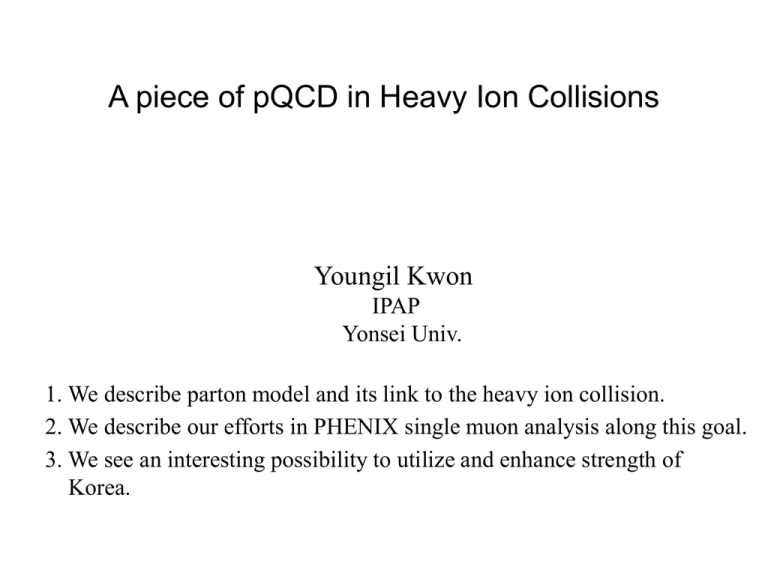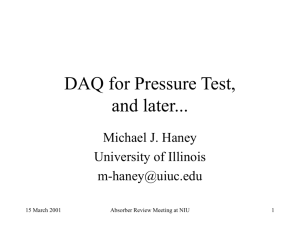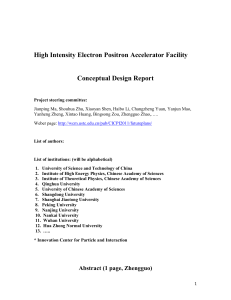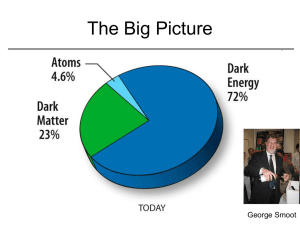A piece of pQCD in Heavy Ion Collisions
advertisement

A piece of pQCD in Heavy Ion Collisions Youngil Kwon IPAP Yonsei Univ. 1. We describe parton model and its link to the heavy ion collision. 2. We describe our efforts in PHENIX single muon analysis along this goal. 3. We see an interesting possibility to utilize and enhance strength of Korea. A picture of hadron From hadron spectroscopy We know there are 2 or 3 quarks Inside hadrons. Can we really see them? If we take a snapshot with an exposure dt ~ 2 fm/c, range : c dt ~ 2 fm, virtuality : dE ~ 0.1 (GeV) For shorter exposure ( harder process ), we see smaller scale Evolution of hadron collision ( slow movie ) New physics? Factorization theorem ds [A+BH+X] = Sij fi/A fj/B ds [ijcc+X] DcH + ... fi/A, fj/B : distribution fuction for parton i,j DcH : fragmentation function for c d+Au ds [ijcc+X] : parton cross section + ... : higher twist (power suppressed by LQCD/mc, or LQCD/pt if pt ≫mc ) : e.g. "recombination" PRL, 89 122002 (2002) Application to nuclei: Au+Au fi/Au 79 fi/p + 118 fi/n 197 fi/N fi/d fi/p + fi/n 2 fi/N Binary scaling not working for high pt particles in central AuAu collisions! PHENIX: PRL, 91, 072303 (2003) Lepton from the heavy flavor decay The PHENIX Experiment (12 Countries; 58 Institutions; 480 Participants as of January 2004) Event characterization detectors Two central arms for measuring hadrons, photons and electrons Two forward arms for measuring muons Major sources of inclusive tracks 2 : Charged /K's, "decaying" before absorber (≤1%) Identifier 3 : Hadrons, penetrating and interacting ("stopped") 4 : Hadrons, "punchthrough" 5 : Prompt muons, desired signal Tracker Absorber 2 3 1 : Hadrons, interacting and absorbed 1 Collision 4 5 Collision range Symbols Absorber Detector Muon Hadron DATA Purity of track? Absorber Dominant Multiple Scattering X pmean dq dq X2 f ( X ) C0 X exp( 2 ) 2s s ~ 0.13 (GeV/c) Collision Collision range Determined by absorber thickness Charged /K's, "decaying" before absorber Identifier Tracker Absorber Average flight distance Collision range Decay muons as Signals ! μ μ+ - Red and blue lines show statistical uncertainty. Green band represents systematic uncertainty. Red and blue dotted lines correspond to expectation. Hadrons, penetrating and interacting ("stopped") Momentum distribution of the tracks with DEPTH 4 Lose all of its energy by ionization Stopping tracks Large momenta to reach the last MuId layer, but hadron interaction in the last absorber layer to stop before last MuId layer. Interacting hadrons Hadrons as Signals ! As a by-product, measured backgrounds (abundant hadrons, especially stopped hadrons in MuId) also lead to an interesting physics (study of shadowing/saturation). d Rcp: nuclear modification factor Central Au Phenix Preliminary Depletion on the d-going side ( low x partons in Au) : Shadowing/suppression region (depletion of low x in Au compared to nucleon) Prompt muon production: In Progress Remaining to the measurement of the prompt yields, Ninclusive – Ndecay – Npunch through = Nprompt + Nbackground In Control Expected plot No absolute value yet; It’s a big collaboration… (about 10-20%) A rising problems in current/future experiment Quickly developing data collection capability ( ~ a few Tbyte/day as of today ) produces a big challenge and many limitations to the data processing and subsequent analysis. This is especially so in the heavy ion experiment where data serve various possibilities and experimental trigger is limited. Currently occuring to PHENIX. Possibilities in Korea Domestic production of key computer parts : Momory ~ big program & multiple processes hard disk ~ effective low cost storage ( instantly, simultaneously & randomly accessible ) Popular uses of PC's ~ omnipresent in low duty factor Exploration & utilization? Current groupexperienced substantial for the analysis from this advantage. Even greator possibility is seen if we gain help additional experiences. Competative data processing and analysis will be possible with this.







